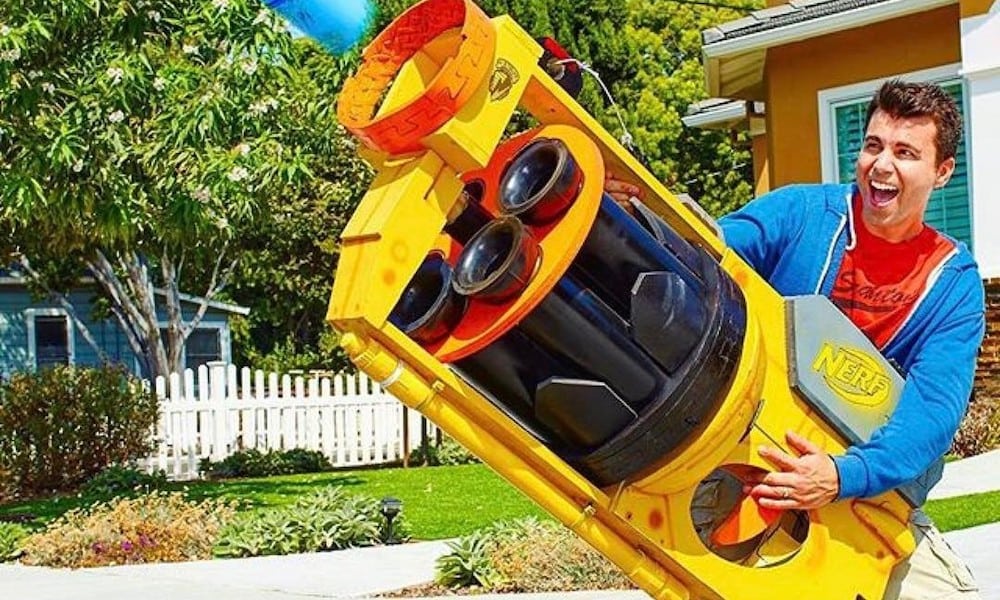Is This YouTube Star Engineering Apple’s Self-Driving Car Tech?
 Credit: Mark Rober
Credit: Mark Rober
Toggle Dark Mode
A new report out this week asserts that famed YouTube star Mark Rober, whose science and technology channel has amassed a whopping 3.4+ million subscribers, might also be working for Apple as an engineer with the company’s highly-selective “special projects” group.
Without citing sources, but pointing to a number of ostensible giveaways, Variety reported that Rober has been assigned to the Cupertino-company’s virtual reality (VR) products division, where he’s believed to be working on the development of VR hardware technologies specifically poised to benefit the future of self-driving cars.
Adding fuel to the fire of Variety’s claims are at least two Apple patents covering the integration of VR technologies within self-driving car applications — both of which credit Rober as lead inventor.
Moreover, according to the YouTube personality’s official LinkedIn profile, Rober switched jobs in 2015 — leaving his position as VP of New Product Design with Morph Costumes and moving on to a “product design engineer position” with an unnamed but “large tech company” headquartered in the San Francisco Bay Area, he confirmed in a Reddit AmA forum late last year.
Two VR Patents
As far as the two Apple patents filed in his name, the U.S. Patent and Trademark Office (USPTO) notes in filings that Rober invented several mechanisms which apply VR hardware technologies in the maneuvering of self-driving cars.
In the first patent, No. 20180089900, filed back in September 2016, Rober describes in detail the concept of an ‘Augmented Virtual Display’ that’s intended to minimize motion sickness when viewing VR content in a moving vehicle.
Specifically, the patent describes a novel technique by which “content is projected through a head-mounted display or similar equipment” which is then able to sync with car acceleration input gathered by onboard sensors.
In some embodiments, the implementation of “active seats,” HVAC systems, and/or “other mechanical apparatus” are applied to help “negate the effects of motion sickness sometimes experienced by passengers who operate digital devices or focus on stationary objects while a car is moving,” Apple Insider explains.
Such a system could be used for either productivity or entertainment purposes; for example, to participate in a remote conference call, or even watch a movie while the vehicle is in motion, according to Apple’s patent literature.
Another, more intriguing embodiment of Rober’s Augmented Virtual Display patent describes a method of autonomously controlling vehicle propulsion and steering systems — allowing a passenger to participate in a VR-styled race with “real-world motion effects.”
In Rober’s second patent application, No. 20180089901, the YouTuber describes an ‘Immersive Virtual Display,’ which is essentially another method of reducing motion sickness in a self-driving car that functions “by displaying a replacing real-world views with a rich virtual environment.”
Of course, given these are both Apple patent applications, there’s no telling if or when the company will ever commercialize an actual product along these lines — however the iPhone-maker’s ambitions in the self-driving car space are well documented.
Project Titan
Back in 2014, news of Apple’s self-driving car aspirations — dubbed Project Titan — began circulating the web, initially suggesting the company had formed a team of over 1,000+ engineers, designers and hardware/software specialists to work on the development of an Apple-branded autonomous vehicle.
Initially, Apple’s plans involved developing a whole new vehicle design and infrastructure from the ground-up — however the endeavor soon proved itself a lofty one, and in the years since Apple has reportedly shifted focus away from developing an actual car, to developing the underlying software infrastructure capable of powering it.
Amid internal power struggles and complications, long-time Apple executive Bob Mansfield took over as head of the Project Titan initiative early last year, prior to whittling the team down to a select few personnel who could best help Apple achieve its new goal of developing this autonomous car software.
Most recently, Apple obtained the necessary permits from the State of California DMV to begin testing self-driving cars on open roads in the Golden State, and Apple has since acquired its own fleet of Lexus RX400h SUVs which it’s begun testing, accordingly.
Last month, Apple announced a special partnership with Volkswagen under the terms of which the German auto-makers would produce a small fleet of Autonomous, Electric Vans to help the company further its PAIL — or Palo Alto to Infinite Loop — initiative.
[The information provided in this article has NOT been confirmed by Apple and may be speculation. Provided details may not be factual. Take all rumors, tech or otherwise, with a grain of salt.]






